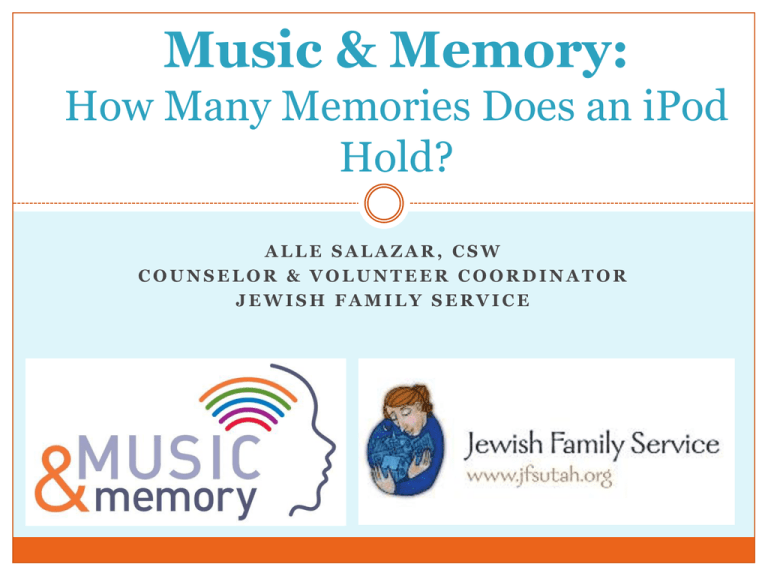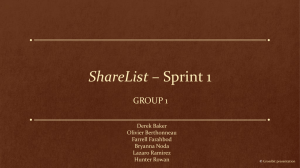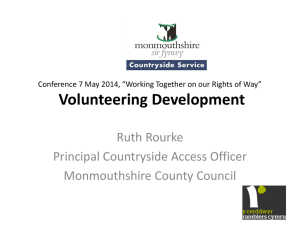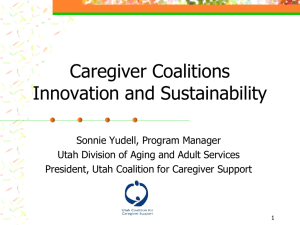ppt - Utah Aging & Disability Resource Connection
advertisement

Music & Memory: How Many Memories Does an iPod Hold? ALLE SALAZAR, CSW COUNSELOR & VOLUNTEER COORDINATOR JEWISH FAMILY SERVICE The Music & Memory Program iPod-based personalized playlists to older adults and individuals suffering from dementia or other chronic illness, such as: Depression Isolation Visual impairment Mental health concerns Palliative care Hospice Cancer Multiple Sclerosis Why Does It Work With Cognitive Decline? Music is profoundly linked to personal memories Our brains are hard-wired to connect music with long-term memory For individuals with dementia, more recent memory for things (names, places, facts) are compromised, but memories from younger years are well preserved What are the Benefits? Numerous outcomes studies find that Music & Memory has significant positive impacts Increased awareness, cognition, and engagement Reduced agitation, anxiety, and problematic behaviors Pain and depression reduction Improved communication Restored sense of identity and increased socialization Increased mobility The History of Music & Memory Dan Cohen, a social worker in New York, began thinking about wide availability of technology and how it could be used for elderly He wondered what it would be like to live without his favorite music He searched online and found that nursing homes were not using this technology He volunteered at a local facility to test the idea The History of Music & Memory Received funding from the Shelley & Donald Rubin Foundation to expand program further Established program as a non-profit As of August 2014, the program is available in: 6 countries 44 states 600 facilities or community organizations Almost exclusively in long-term care settings See For Yourself… Henry’s Story http://www.youtube.com/watch?v=fyZQf0p73QM&feature=pl ayer_embedded Alive Inside After the Henry clip was made, Michael Rosato- Bennett, a filmmaker, followed Dan for the next 3 years Featured at Sundance 2014 Audience Award for Best US Documentary Release in select theaters in June 2014 Anticipated upcoming Netflix debut this Fall How Did JFS Discover Music & Memory? Henry’s story went viral NPR Story about Henry was shared with staff at JFS We connected with Dan to find out how we could be involved Program seemed adaptable to our services Dan was responsive and supportive in this process Why Is This A Good Fit for JFS? JFS Non-denominational private non-profit 501c3 Funded by grants and individual donations Sliding fee scale for all services Mission Statement JFS seeks to strengthen individuals, families, and communities through counseling, care management, and community education We focus on support for caregivers and those striving to age-inplace Also offer support and referrals when necessary to move to longterm care Why is This a Good Fit for JFS? Our goal to help individuals age in place Offering the program in the community supports aging in place Supports caregivers and family as a means of respite and connection Administrative Considerations Meets mission of organization Arts programming (never before offered at JFS) Expands current, and opens new funding streams for grants and donations Utilizes a strong volunteer component, which is a strength of the agency Utah’s Music & Memory Presence JFS was certified as a Music & Memory organization in January 2014 3 day webinar, 1.5 hours each day First organization in Utah to be certified Only organization in Utah providing community-based programming at this time Now in 40 facilities throughout Utah A complete list can be found at www.musicandmemory.org Our Process Client is Referred to the Program Volunteer Completes Music Interview with Client (and CG if applicable) In-Home Assessment is Completed with Client (and CG if applicable) Client or CG pays $50 one time fee if able Client is Matched with Volunteer Volunteer Downloads/Uploads Music for Playlist and Loads onto Device Volunteer Introduces iPod to Client, Demonstrates Use, Establishes Charging Plan Volunteer Follows Up After a Week’s Time, and After As Needed The Assessment & Referral Process In-Home Assessment Environment Personality/temperament Making A Referral Client or family can contact us You can contact us with client information with their expressed permission Role of Volunteers The fun stuff! Responsibilities: Interview program recipients and caregivers about music preferences Download and assemble recipient’s personalized iPod playlist using iTunes gift cards Load playlist onto donated iPod (preferably iPod Shuffle) Introduce playlist to recipient and make changes as necessary The Music Interview Goal: Identify 80-100 song selections 10-15 favorite artists Checklists of frequently identified music and music interview provided by the program A few of the questions: What music did you listen to when you were young? Did you sing at religious services? What were your favorite hymns? Did you go to shows or musicals? Did you go dancing? Do you have any records, tapes, or CDs of your favorite music? Where can I find them? What songs did you dance to at your wedding? High school prom? What Kind of Music Do They Like? A little bit of everything! Music preferences vary as much as the people being served Danish Israeli Christian Hymns Big Band Country Rock & Roll Soul Opera Classical Broadway Patriotic And Much More Our iTunes Library After 5 months of providing the program, our iTunes library is vast, and always growing More than 30GB of music 12 days Over 4,600 songs Challenges & Lessons Learned iTunes Some volunteers aren’t familiar with iTunes They may or may not want to learn Use specific volunteers for specific parts of the project Assess skill sets, commitment, and interest Goal Recommended Qualities & Skills Establish a well-organized music library •Passion for finding the right music for each person •Enjoys researching music •Understands iTunes •Computer savvy •Detail oriented Research Favorite Music •Excellent communication skills •Thoughtful listener •Compassion for and interest in elders •Adept at note-taking Teach Client/Resident How to Use iPod •Understand use of device •Excellent oral communication skills •Empathetic and patient •Enjoys teaching Challenges & Lessons Learned Facility Computer Limits volunteer’s freedom Have to schedule computer time Increased staff time because of full-time working volunteers May be easier to accommodate in long-term care setting Donations iPods often come without charging equipment iTunes gift cards are less often donated They forget to listen, or how to use device Volunteers encouraged to check in on challenges Caregivers and family can assist if available In long-term care settings, this may be easier Structure Staff to assist Where We Are… JFS (as of August 2014) Clients Served: 19 Volunteers Trained: 14 Feedback “She seemed to tolerate the earphones without any problem, and my sister and I noted that she seemed to pay attention to the music even when her eyes were closed. She would tap her feet, hum as if trying to sing, and smile in apparent recognition of familiar songs… We were able to do 30 minute sessions in three successive days. After each listening session, our mother was more alert, interactive, and her mood was positive for a significant interval. It was wonderful to be able to give my mom a little pleasure in her day.” “He really seemed to enjoy listening to the music. He was humming and singing along…And I love the thought that he might be comforted and receive some joy from the music - and the memories.” “My dad listens to his iPod every day. He sings along and smiles widely. He tells stories I’ve never heard about his youth. This has opened up such a meaningful opportunity to connect with my father again. Thank you for providing this program.” Community Collaborations Skullcandy Zion’s Bank donation of $100,000 toward equipment Skullcandy’s ethnographic research Center for Alzheimer’s Care, Imaging, and Research (CACIR)- University of Utah fMRIs of brain activity of those affected with dementia listening to their custom iPods Awaiting IRB approval Utah Coalition for Music & Memory A collaborative group of government, non-profit, Music & Memory representatives, Skullcandy, and other senior care professionals Traction in Facility Settings The Utah Health Care Association Grant for Music & Memory in all member facilities 40 facilities thus far certified and trained 100 total planned 15 residents in each facility will be provided with program to start A complete list can be found at www.musicandmemory.org All of this work, JFS and Utah HCA included, has happened since January of this year What Would Be On YOUR Playlist? Consider music’s power to bring us back to memories in a vivid way What songs do this for you? Why? What would be a must for your playlist? Questions? Comments? Please feel free to make referrals as necessary Alle Salazar, CSW Jewish Family Service 1111 E Brickyard Rd, Suite 218 Salt Lake City, UT 84106 801.746.4334 alle@jfsutah.org







